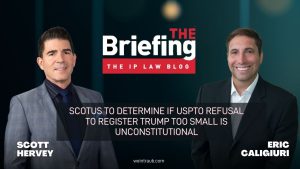 The Supreme Court recently heard oral arguments in the case of Vidal v. Elster to determine whether the USPTO’s refusal to register the trademark “Trump Too Small” violates the applicant’s First Amendment rights. Scott Hervey and Eric Caligiuri discuss this case on this installment of The Briefing.
The Supreme Court recently heard oral arguments in the case of Vidal v. Elster to determine whether the USPTO’s refusal to register the trademark “Trump Too Small” violates the applicant’s First Amendment rights. Scott Hervey and Eric Caligiuri discuss this case on this installment of The Briefing.
Watch this episode on the Weintraub YouTube channel here.
Show Notes:
Scott:
Today, November 1, 2023, the Supreme Court will hear oral arguments on whether the Trademark Office’s refusal to register the trademark “Trump Too Small” on the grounds that it violates Section Two C of the Lanham Act, which bans the issuance of trademarks that include the names identifying a particular individual without that individual’s consent violates the applicant’s First Amendment rights. We are going to talk about this case on this installment of The Briefing by Weintraub Tobin. The case is Vidal v. Elster. The facts are relatively simple. Elster sought to register the mark “Trump Too Small” for T-shirts. The USPTO refused to register the mark based on section Two C of the Lanham Act, which bans the issuance of trademarks that include the names identifying a particular individual without that individual’s consent. Elster appealed this refusal to the Federal Circuit, where Judge Timothy B. Dyke held for a unanimous panel that the government’s interest in protecting the privacy and publicity rights of President Trump did not outweigh Elster’s First Amendment right to criticize that public figure.
Eric:
USPTO suspended the examination of applications of trademarks that cover phrases that are critical of government officials or public figures and petitioned the Supreme Court for review?
Scott:
That’s right. The question for review by the Supreme Court is whether the Section Two C Bar of the Registerability of trademarks that identify a particular individual without their consent, including those that are critical of government officials or public figures, is a condition of a government benefit, the trademark registration, or a restriction on speech.
Eric:
So let’s talk about this in light of Matal vs. Tam, which struck down a ban on trademarks that may disparage groups of people, which included marks that incorporated racist or demeaning terms on First Amendment grounds, and also Iancu v. Brunetti that invalidated a ban on profane or lewd trademarks, also on First Amendment grounds.
Scott:
That’s a good point, Eric. In its petition to the Supreme Court, the USPTO distinguished these two cases from this instant case. The USPTO argued that the restrictions at issue in Tam and Brunetti were viewpoint-based restrictions. The USPTO contends that Section Two C is viewpoint neutral, meaning it doesn’t matter whether the application is for a mark that is critical of a live person, complimentary of a live person, or neutral. If the mark contains the name of a live individual, it can’t be registered without their consent under section two C.
Eric:
So, Scott, putting aside the argument that Section Two C is a viewpoint neutral, do you think that the trademark Office’s refusal to register Chill’s political speech?
Scott:
I don’t remember. Registered trademark is a protectable right. So what happens if this applicant was granted registration? Then, others who want to express a similar political sentiment on a T-shirt or a bumper sticker would be prohibited from doing so. The granting of a trademark registration to Marx that includes political criticism of notable figures would actually limit that kind of speech. Specifically, the office stated that it is the registration of marks like the respondents, not the refusal to register them, that would chill such speech.
Eric:
Thanks, Scott. Very interesting. Be sure to update us when the Supreme Court issues a ruling.
Scott:
I certainly will. Thank you for listening to this episode of the Briefing. We hope you enjoyed this episode. If you did, please remember to subscribe, leave us a review, and share this episode with your friends and colleagues. And if you have any questions about the topics we covered today, please leave us a commentary.
Podcast: Play in new window | Download